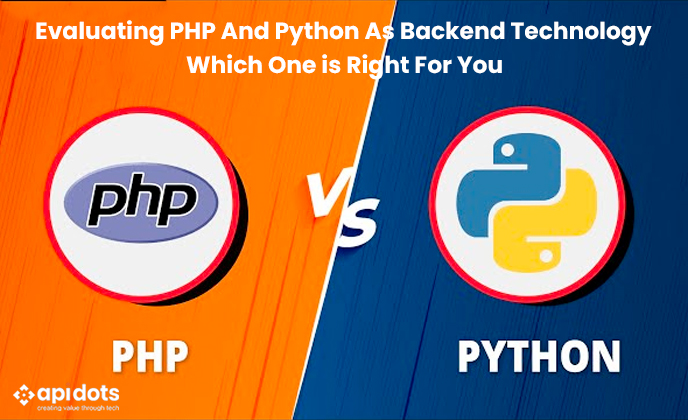
Top
Search
People also search for:
- Home
- Evaluating PHP And Python As Backend Technologies – Which One is Right For You


Choosing the right server technology is important for developers and professionals who want to build reliable and scalable web applications. PHP and Python are two of the most popular options among the many options available.
In this in-depth guide, we’ll dive into the strengths and weaknesses of PHP and Python as server-side technologies to help you make informed decisions based on your project’s needs.
PHP, which stands for Hypertext Preprocessor, is a server-side scripting language designed for web development.
It is widely used to create dynamic web pages and has dominated the world of web development for over two decades.
PHP is embedded in HTML code and runs on the server, generating dynamic content sent to the client browser.
PHP’s syntax is simple and very similar to C languages, making it easier for developers, especially those with programming experience, to learn.
Additionally, PHP is supported by a large community, meaning that resources and support are relatively easy to find.
Being a server-side scripting language, PHP excels at server-side tasks. It excels at data processing, database interaction, and user session management, making it an excellent choice for server-side development.
PHP easily integrates with the LAMP (Linux, Apache, MySQL, PHP/Python/Perl) stack, making it a popular web development framework.
This integration ensures compatibility and smooth operation of the entire stack, promoting the widespread use of PHP.
Although PHP is suitable for small to medium-sized projects, it can run into problems when dealing with large-scale applications.
Scaling PHP applications can be more difficult compared to some other server technologies.
The PHP standard library can be inconsistent, and the language lacks a standardized way of handling different functions.
This creates potential pitfalls for developers who may have to rely on third-party libraries to resolve these inconsistencies.
Python is a high-level, general-purpose programming language known for its readability and versatility.
Originally developed as a scripting language, Python has evolved into a robust language with extensive libraries and frameworks that are suitable for a wide range of applications, including web development.
Python syntax is clean and readable, with an emphasis on code readability.
This feature simplifies debugging and maintenance processes, making it an excellent choice for large and complex projects.
Python boasts a rich ecosystem of libraries and frameworks.
For example, Django and Flask, optimize development processes. These tools allow developers to speed up their backend development without sacrificing code quality.
Python has an active community that continues to contribute to its development.
This support ensures that developers have access to resources, documentation, and third-party packages to improve their projects.
Also Read | Web Apps vs. Hybrid Apps vs. Native Apps
Although Python’s performance has improved thanks to advances such as Just-In-Time (JIT) compilation, it can still lag behind some languages in terms of raw speed.
Python may not be the optimal choice for computationally intensive tasks.
Python’s global interpreter locking can create concurrency problems, limiting the language’s ability to fully utilize multi-core processors.
This issue may affect the scalability of Python applications in certain scenarios.
PHP and Python have different performance characteristics. PHP is known for its speed in processing web requests, making it suitable for high-traffic web applications.
On the other hand, Python’s performance may lag in certain scenarios, especially computationally intensive tasks.
PHP’s syntax is more reminiscent of a traditional programming language, while Python’s emphasis on readability is evident in its clean, concise syntax.
The choice among them may depend on the preferences of your team and the nature of your project.
Both PHP and Python have robust ecosystems, but their platforms are different.
PHP is often associated with frameworks such as Laravel and Symfony, while Python includes Django and Flask.
Consider the unique features and architecture of these frameworks and match them to your project needs.
PHP has a large and established community, and Python also has a large and growing community.
When evaluating these technologies for your project, consider the availability of resources, documentation, and community support.
Also Read | Shopify vs. Magento: Unveiling the Best Ecommerce Platform for Your Business
Choosing between PHP and Python as server technology is a careful consideration of many factors, including the nature of your project, team preferences, and specific needs.
Both languages have a proven track record in web development, and your solution should fit the goals and constraints of your project.
PHP may be the preferred choice for projects where fast development and ease of learning are important.
On the other hand, if readability, maintainability, and a large ecosystem of libraries and frameworks are of paramount importance, then Python may be the ideal backend technology for your web application.
Ultimately, the “right” choice depends on your specific circumstances and goals.
Whatever technology you choose, stay up to date with the latest developments in PHP and Python to ensure your web applications remain efficient, secure, and well-supported in the ever-changing backend development environment.